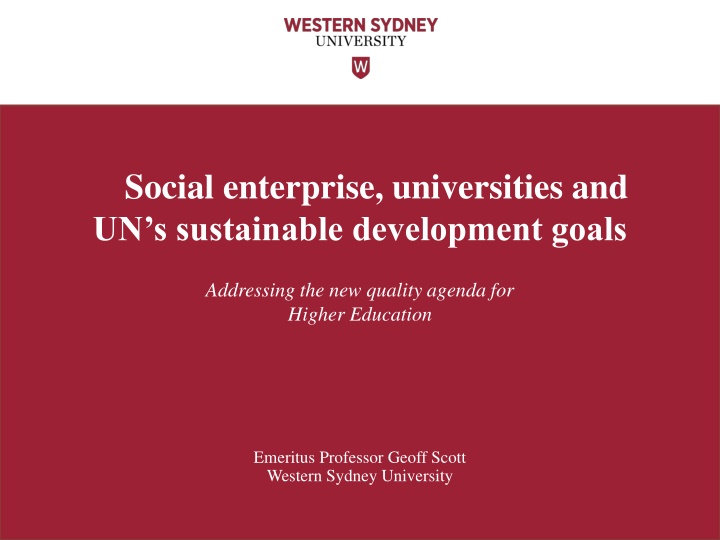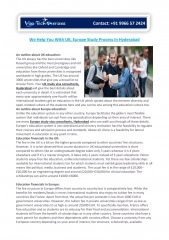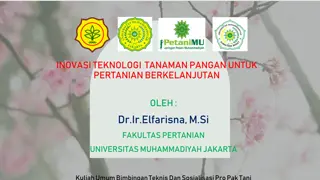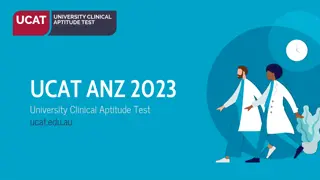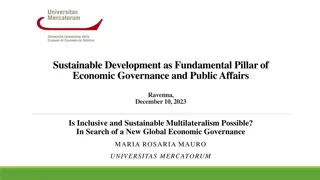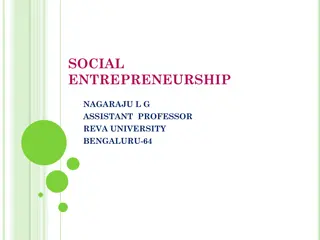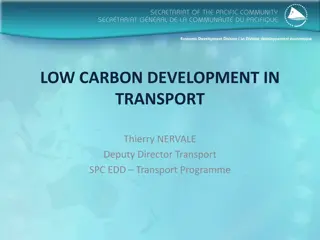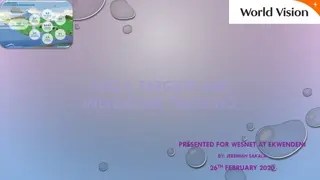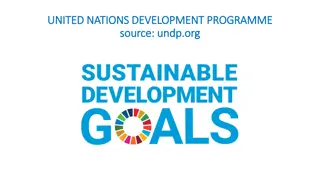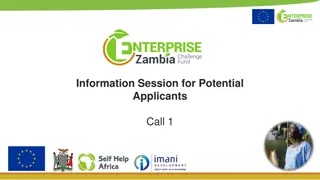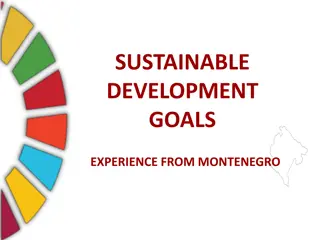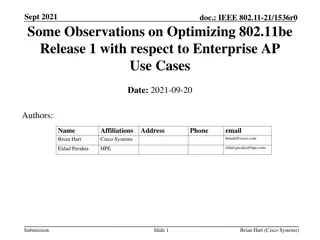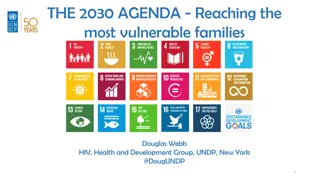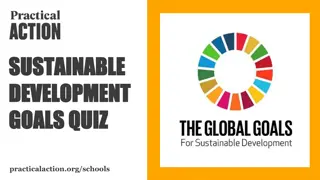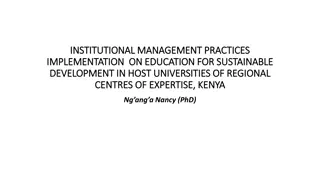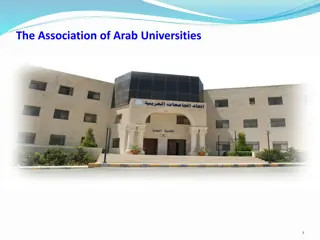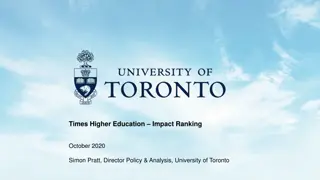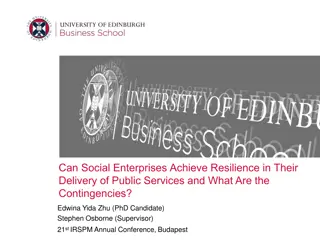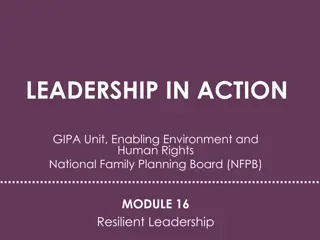Social Enterprise & Universities Addressing UN Sustainable Development Goals
This content discusses the role of social enterprise and universities in addressing the UN Sustainable Development Goals, emphasizing the importance of preparing graduates for a changing world. It explores key themes such as social entrepreneurship, innovation for social benefit, and the significance of aligning education with sustainable development objectives.
Download Presentation

Please find below an Image/Link to download the presentation.
The content on the website is provided AS IS for your information and personal use only. It may not be sold, licensed, or shared on other websites without obtaining consent from the author.If you encounter any issues during the download, it is possible that the publisher has removed the file from their server.
You are allowed to download the files provided on this website for personal or commercial use, subject to the condition that they are used lawfully. All files are the property of their respective owners.
The content on the website is provided AS IS for your information and personal use only. It may not be sold, licensed, or shared on other websites without obtaining consent from the author.
E N D
Presentation Transcript
Social enterprise, universities and UN s sustainable development goals Addressing the new quality agenda for Higher Education Emeritus Professor Geoff Scott Western Sydney University
Key themes Work ready plus graduates need opportunities to explore invention for social benefit in their studies A focus on social not just commercial entrepreneurship is necessary Colleges and Universities are ideally positioned to help their country address the UN Sustainable Development Goals through entrepreneurship projects Good ideas with no ideas on how to implement them are wasted ideas
Why bother? Ensuring the fitness of purpose not just the fitness for purpose of our tertiary education programs In the current context we need graduates who are not only work ready for today (competent) but work ready plus (capable) for an uncertain tomorrow 95% of the world s political leaders have a degree We need graduates who are practiced in developing and implementing solutions to the challenges of social, cultural and environmental sustainability not just economic sustainability Universities & colleges are uniquely positioned to help their country address the UN s Sustainable Development Goals Social enterprise aligns with key objectives for the development of many countries and the moral purpose of their approach to education. Students want these sorts of experiences as part of their college/university studies What is assessed is what is learnt
UN Sustainable Development Goals 2030 1. 2. 3. 4. 5. 6. 7. 8. 9. 10. Reduced inequality 11. Sustainable cities & communities 12. Responsible consumption & production 13. Climate action 14. Life below water 15. Life on land 16. Peace, justice & strong institutions 17. Partnerships to achieve the goals No poverty Zero Hunger Good health & well-being Quality Education (including sustainability in the curriculum) Gender Equality Clean water Affordable & clean energy Decent work & economic growth Industry, innovation & infrastructure
Defining social entrepreneurship A social enterprise has a social and/or environmental mission as part of its core purpose. Such organizations seek profits only in order to achieve their missions. Social entrepreneurship relates to entrepreneurial action by organisations and individuals that creates significant social value for communities and people. It involves Identifying an unjust situation, a need for change; identifying an opportunity in this unjust equilibrium, developing a social value proposition, and bringing to bear inspiration, creativity, to identify a relevant and feasible way to improve the situation; Trialing, implementing, enhancing and then scaling up what works best; Whilst ensuring that there are sufficient funds to support and sustain this work Commercial entrepreneurship is about personal benefit and profit maximisation. Social entrepreneurship is about benefitting others such enterprises make money but no one takes it out the profits are dedicated solely to scale up
Judging that a social enterprise is successful Money is being made out of waste - cradle to cradle design is in place Minimum defaults on micro-finance loans Positive health outcomes Gross domestic happiness (Bhutan); improved social harmony; decreased crime rates; NZ s well-being budget 2019 More equitable distribution of wealth Increased participation in post-secondary education/employment Positive feedback from participants Successful scale up and sustainability of the initiative Government and legislative support for scale up Repeat business Positive press coverage Positive rate of return on investment High position on the Times HE Impact Rankings 2019
Examples of social entrepreneurship linked to the SDGs Mobile phones and food security in Sri Lanka Sanduk Ruit and interocular lenses in Nepal Spinnifex and nanocellulose in Australia Citrus Farm and the Foskor development trust in South Africa Maggots in Benin 3D solar souvenirs made by the rubbish pickers in Delhi Fast fashion , biolitics and the circular economy Pig farms and African snails in the Pacific The NWU Enterprising Women Programme and Student Rag Community Service initiatives
Examples of social entrepreneurship linked to the SDGs Harvard s Living lab projects The Harvard campus sustainability fund, Bubble box, Daniel Nocera s artificial leaf Biomimicry inventions SunTile which uses jackrabbits ears as a model for cooling computer rooms with no energy, use of termite mounds to design the Eastgate Centre in Zimbabwe, Eco-friendly sewerage treatment based on the 4 chambers of a cow s stomach, Velcro, Permanent colours based on the structure of butterfly wings Citizen intelligence and SDGs 11 and 16 Western Sydney University Riverfarm and SURF projects WSU first in Australia and 11thin the world on the new Times SDG impact rankings
International Links and Networks interested in Social Enterprise and the SDGs The Social Enterprise World Forum Christchurch 2017 The International Conference of Entrepreneurship Educators Oxford September 2019 The Association of Commonwealth Universities, The Global Alliance of Universities SDG accord and the International Association of Universities are all now giving focus to ESD The Alliance for Sustainability Leadership in the UK The Social Enterprise Academy Oikos St Galen
Characteristics of an effective social entrepreneur Strong, clear moral purpose Ability to listen, link, leverage then lead, always in that order A why don t we not a why don t you approach Possession of the key capabilities identified in our studies of successful early career graduates in nine professions, including the ability to: remain calm when things go awry, tolerate ambiguity, take sensible risks and persevere, work productively and empathise with diversity, think laterally, think ahead and adapt, Build and sustain productive networks. Business and change implementation savvy
Where social enterprise capabilities fit into an overall Quality & Standards framework for Learning & Teaching 1. Learning design 4. Impact 2. Aligned support & infrastructure 3. Delivery Aligned governance, policy, strategy, quality management & resourcing system
What are learning outcomes? The capabilities and competencies students are expected to demonstrate they have developed to a required standard by the end of a program or unit of study They include personal, interpersonal and cognitive capabilities and the key knowledge and skills necessary for effective early career performance and societal participation (See successful graduate studies for a valid framework)
The idea of producing work ready plus graduates People who are not just work ready for today but work ready plus for tomorrow (95% of the world s leaders have a degree). The plus can include being: Sustainability literate Change implementation savvy Creative and inventive not just regurgitative Clear on where one stands on the tacit assumptions driving the 21st century agenda, assumptions like: - growth is good - consumption is happiness - ICT is always the answer - globalisation is great
Social Enterprise in the curriculum UN Regional Centres of Expertise in Education for Sustainable Development Campus as a living laboratory Rolling funds and a social entrepreneurship unit of study WSU Riverfarm Social Studio in Melbourne pathways to further study Sydney School of Entrepreneurship Blue Economy on the campus and in HE community engagement projects Redevelopment of the Royal University of Phonm Penh 2010 audit of sustainability in the HE curriculum National networks: AASHE, ACTS, Copernicus NSW TAFE Outreach programs See the full list of programs now underway in the discussion paper
Making it happen Listen, link, leverage then lead Start small, learn by doing and build on your successes - ready, fire, aim Undertake a stocktake on what is already happening and build a good practice website on this acknowledge current initiatives In identifying good practice use agreed indicators of what success in practice looks like Develop a national clearing house to save reinvention of the wheel Promote initiatives in this area as a unique focus on your national provision to international students For further suggestions see the Making it Happen Section of the FLIPCurric site at: http://flipcurric.edu.au/
Key insights and what next? One aspect of this talk you found particularly interesting One aspect you would like to know more about What is one initiative you think CSU should now pursue?
Further reading and resources British Council (2017): Social entrepreneurship in education: empowering the next generation, British Council, At:https://www.britishcouncil.org/sites/default/files/british_council_social_entrepreneurship_in_education_web_final.pdf Martin, R & Osberg, S (2007): Social Entrepreneurship: The Case for Definition , Stanford SocialInnovation Review At: https://ssir.org/articles/entry/social_entrepreneurship_the_case_for_definition Mills, Rebecca and Siegfried, Alina (2015), Mission driven entrepreneurship: new frontiers of impact entrepreneurship, Edmund Hillary Fellowship, At: https://stories.ehf.org/the-new-frontiers-of-impact-entrepreneurship-cc6cbce64f0c Schwab Foundation (2018): What is social entrepeneurship? Schwab Foundation in partnership with the World Economic Forum at: https://www.schwabfound.org/what-is-social- entrepreneurship Scott, G (2016): FLIPCurricat: http://flipcurric.edu.au/ OLT, Canberra. Scott, G (2016): Transforming graduate capabilities and achievement standards for a sustainable future,At: http://flipcurric.edu.au/sites/flipcurric/media/107.pdf Scott, G (2019): Preparing work ready plus graduates for an uncertain future In Higgs, J, Crisp, G and Letts, W (2019): Education for Employability: learning for future possibilities , Brill, Leiden, Boston & Singapore. Scott, G (2019): Social Enterprise and Sustainable Development in the Age of Acceleration, Envigogika 14 (1) March, 2019 Social Enterprise Word Forum (2017): 2017 Final Report, SEWF, Christchurch, New Zealand. At: https://www.sewf2017.org/images/docs/SEWF-2017-Final-Report.pdf United Nations University (2018): The Blue Economy Innovations, Gunther Pauli & UNU at: https://www.theblueeconomy.org/cases-1-to-100.html
